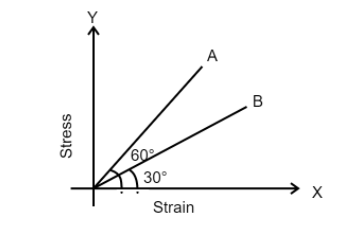
The stress versus strain graphs for wires of two materials (A)and (B) are as shown in the figure. If ${Y_A}$and ${Y_B}$ are Young's moduli of the materials, then:

(A) ${Y_B} = 2{Y_A}$
(B) ${Y_B} = {Y_A}$
(C) ${Y_B} = 3{Y_A}$
(D) $3{Y_B} = {Y_A}$
Answer
140.4k+ views
.Hint. We solve this question by finding the values of Young’s modulus for both the materials. We find Young’s modulus by finding the slope of the line in the graph for each material. We find the slope by using trigonometric properties. The angle made by the line in the stress vs strain graph is already given. By using these angles in trigonometry properties to find Young’s modulus we get a relation between ${Y_A}$and ${Y_B}$
Complete step by step answer. The slope of stress vs strain graph gives us Young’s modulus.
In the graph, we are given the angle made by the line in the stress vs strain graph in both cases.
We know that slope is equal to $\tan \theta $
In the case of material (A)
The slope is equal to $\tan 60^\circ $
Material (B)
The slope is equal to $\tan 30^\circ $
We know that slope is equal to Young’s modulus hence
${Y_A} = \tan 60^\circ = \sqrt 3 $
${Y_B} = \tan 30^\circ = \dfrac{1}{{\sqrt 3 }}$
Diving Young’s modulus of (A) with Young’s modulus of (B) we get $\dfrac{{{Y_A}}}{{{Y_B}}} = \dfrac{{\sqrt 3 }}{{\dfrac{1}{{\sqrt 3 }}}} = 3$
Hence $3{Y_B} = {Y_A}$
Option (D) $3{Y_B} = {Y_A}$ is the correct answer.
Additional information Young’s modulus is defined as the measure of ability of a material to withstand changes in length when it is under a lengthwise tension of compression. It is also referred to as modulus of elasticity.
Note We find the slope in the graph by using tanθ because we are assuming the graph as a right-angled triangle. And $\tan \theta $is equal to the opposite by the adjacent side of the assumed triangle. In the case of stress vs strain graph opposite is equal to stress and adjacent is equal to the strain. Hence $\tan \theta $ is equal to Young’s modulus. Therefore, we use $\tan \theta $ to find the slope.
Complete step by step answer. The slope of stress vs strain graph gives us Young’s modulus.
In the graph, we are given the angle made by the line in the stress vs strain graph in both cases.
We know that slope is equal to $\tan \theta $
In the case of material (A)
The slope is equal to $\tan 60^\circ $
Material (B)
The slope is equal to $\tan 30^\circ $
We know that slope is equal to Young’s modulus hence
${Y_A} = \tan 60^\circ = \sqrt 3 $
${Y_B} = \tan 30^\circ = \dfrac{1}{{\sqrt 3 }}$
Diving Young’s modulus of (A) with Young’s modulus of (B) we get $\dfrac{{{Y_A}}}{{{Y_B}}} = \dfrac{{\sqrt 3 }}{{\dfrac{1}{{\sqrt 3 }}}} = 3$
Hence $3{Y_B} = {Y_A}$
Option (D) $3{Y_B} = {Y_A}$ is the correct answer.
Additional information Young’s modulus is defined as the measure of ability of a material to withstand changes in length when it is under a lengthwise tension of compression. It is also referred to as modulus of elasticity.
Note We find the slope in the graph by using tanθ because we are assuming the graph as a right-angled triangle. And $\tan \theta $is equal to the opposite by the adjacent side of the assumed triangle. In the case of stress vs strain graph opposite is equal to stress and adjacent is equal to the strain. Hence $\tan \theta $ is equal to Young’s modulus. Therefore, we use $\tan \theta $ to find the slope.
Recently Updated Pages
Difference Between Circuit Switching and Packet Switching

Difference Between Mass and Weight

JEE Main Participating Colleges 2024 - A Complete List of Top Colleges

JEE Main Maths Paper Pattern 2025 – Marking, Sections & Tips

Sign up for JEE Main 2025 Live Classes - Vedantu

JEE Main 2025 Helpline Numbers - Center Contact, Phone Number, Address

Trending doubts
JEE Main 2025 Session 2: Application Form (Out), Exam Dates (Released), Eligibility, & More

JEE Main 2025: Derivation of Equation of Trajectory in Physics

JEE Main Exam Marking Scheme: Detailed Breakdown of Marks and Negative Marking

Learn About Angle Of Deviation In Prism: JEE Main Physics 2025

Electric Field Due to Uniformly Charged Ring for JEE Main 2025 - Formula and Derivation

JEE Main 2025: Conversion of Galvanometer Into Ammeter And Voltmeter in Physics

Other Pages
Units and Measurements Class 11 Notes: CBSE Physics Chapter 1

JEE Advanced Marks vs Ranks 2025: Understanding Category-wise Qualifying Marks and Previous Year Cut-offs

NCERT Solutions for Class 11 Physics Chapter 1 Units and Measurements

Motion in a Straight Line Class 11 Notes: CBSE Physics Chapter 2

Important Questions for CBSE Class 11 Physics Chapter 1 - Units and Measurement

NCERT Solutions for Class 11 Physics Chapter 2 Motion In A Straight Line




